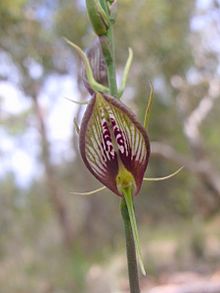- Cryptostylis
-
Cryptostylis Cryptostylis erecta Scientific classification Kingdom: Plantae (unranked): Angiosperms (unranked): Monocots Order: Asparagales Family: Orchidaceae Tribe: Diurideae Subtribe: Cryptostylidinae Genus: Cryptostylis
R. Br.Cryptostylis is a genus of flowering plants from the orchid family, Orchidaceae. It was first defined by the prolific Scottish botanist, Robert Brown in 1810.[1] The type species has since been designated as Cryptostylis erecta. Other species include Cryptostylis hunteriana and Cryptostylis subulata. Molecular study of their DNA shows the genus lies within the tribe Diurideae within the orchid family, having previously considered part of the Cranichideae. Together with the genus Coilochilus they make up the subtribe Cryptostylidinae.[2]
The genus comprises around twenty five species of terrestrial orchid distributed from southern Asia (specifically India and Sri Lanka) Thailand, Malaysia down through Indonesia and into Australia and New Zealand, as well as Samoa, New Caledonia, Vanauatu, the Philippines and Taiwan.[3] Five species are found in Australia, of which three are endemic.[4]
These orchids are single stemmed, either leafless or with one or more large leaves arising from the base of the stalk. The leaf undersides are often purple-hued, coloured with anthocyanin pigments. The flowers occur on racemes, with several found on one flower spike. The roots are rhizomatous, but lack any tuberous structures.[3]
All Australian species are pollinated by the ichneumon wasp known as the orchid dupe wasp (Lissopimpla excelsa). The male wasp mistakes the flower parts for a female wasp and attempts to copulate with it. Although the different species can occur together, they appear to inhibit cross-fertilisation and no hybrids are found in nature.[5] This discovery was made by Australian naturalist Edith Coleman in 1928, and the term coined was "pseudocopulation". The mimicking of flowers to resemble female wasp parts has since been recorded in other orchid genera.[6] The flowers of Cryptostylis orchids and female wasp body parts are very similar in colour when viewed under a hymenopteran visual system, despite looking different to human eyes. Although the colours that ichneumon wasps see are unknown, bees and wasps have similar perception with green, blue and ultraviolet wavelengths.[7]
The Cryptostylis orchids are unusual in that several species are pollinated by the same wasp species; other orchids which mimic insects are often species-specific. The flowers have no smell detectable to humans, but have been shown to have an odour which attracts the orchid dupe wasp. Furthermore gas chromatography and electrophysiology show that the single active compound for pollinator attraction is found in different species of Cryptostylis.[8]
See also
- List of Orchidaceae genera
References
- ^ "Cryptostylis R.Br.". Australian Plant Name Index (APNI), IBIS database. Centre for Plant Biodiversity Research, Australian Government. http://www.anbg.gov.au/cgi-bin/apni?taxon_id=34896.
- ^ Kores PJ, Molvray M, Weston PH, Hopper SD, Brown AP, Cameron KM, Chase MW (2001). "A phylogenetic analysis of Diurideae (Orchidaceae) based on plastid DNA sequence data". American Journal of Botany 88: 1903–14.
- ^ a b Pridgeon, Alec M., Cribb, P.J., Chase, M.A. & Rasmussen, F. (eds.), ed (2001). Genera Orchidacearum 2. Oxford University Press. pp. 118–25. ISBN 0198507100. http://books.google.com.au/books?id=jNFvwlGdTEcC&pg=PA118&dq=cryptostylis&hl=en&ei=hvHpTOmxB4iKvQOE3sHCCA&sa=X&oi=book_result&ct=result&resnum=1&ved=0CCUQ6AEwAA#v=onepage&q=cryptostylis&f=false. Retrieved 22 November 2010.
- ^ Peter H. Weston (2010). "Cryptostylis". Plantnet - NSW Flora Online. New South Wales Herbarium. http://plantnet.rbgsyd.nsw.gov.au/cgi-bin/NSWfl.pl?page=nswfl&lvl=gn&name=Cryptostylis. Retrieved 22 November 2010.
- ^ Robert L. Dressler (1993). Phylogeny and classification of the orchid family. Cambridge, UK: Cambridge University Press. p. 134. ISBN 0521450586. http://books.google.com.au/books?id=4_xL5qOVa-sC&pg=PA134&dq=cryptostylis&hl=en&ei=hvHpTOmxB4iKvQOE3sHCCA&sa=X&oi=book_result&ct=result&resnum=6&ved=0CDwQ6AEwBQ#v=onepage&q=cryptostylis&f=false. Retrieved 22 November 2010.
- ^ Rod Peakall (2007). "Pollination by Sexual Deception in Australian Terrestrial Orchids". Australian National University website. Canberra, ACT: Australian National University. http://www.anu.edu.au/BoZo/orchid_pollination/. Retrieved 22 November 2010.
- ^ A. C. Gaskett, M. E. Herberstein (2010). "Colour mimicry and sexual deception by Tongue orchids (Cryptostylis)". Naturwissenschaften 97: 97–102. doi:10.1007/s00114-009-0611-0. http://www.andreluisacosta.com/Bombusterre/Naturwissenschaften/Communication_2010.pdf. Retrieved 22 November 2010.
- ^ Schiestl, Florian P.; Peakall, Rod; Mant, Jim (2004). "Chemical communication in the sexually deceptive orchid genus Cryptostylis". Botanical Journal of the Linnean Society 144 (2): 199–205. doi:10.1111/j.1095-8339.2003.00249.x.
- Berg Pana, H. 2005. Handbuch der Orchideen-Namen. Dictionary of Orchid Names. Dizionario dei nomi delle orchidee. Ulmer, Stuttgart
Categories:- Orchid genera
- Cryptostylis
- Plants and pollinators
Wikimedia Foundation. 2010.

